Build Your Own Self Watering Containers
This post may contain affiliate links, which means that I may receive a commission if you make a purchase using these links. As an Amazon Associate I earn from qualifying purchases.
Many versions of self watering containers, also known as self watering grow boxes, self watering pots, and self watering planters are sold online, but you can make them yourself for a fraction of the cost out of some easy to find items.
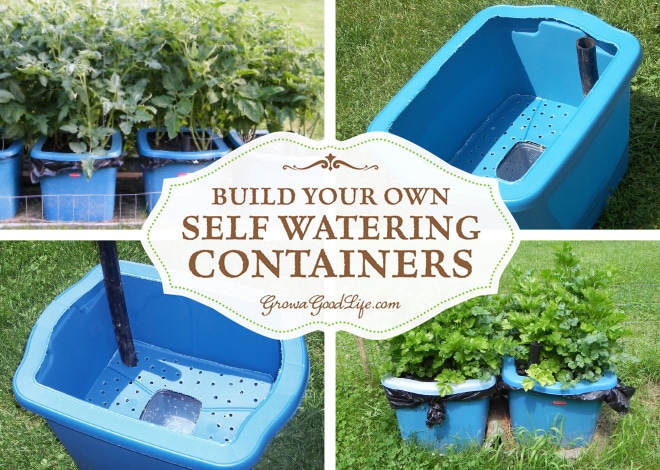
This post on constructing self watering containers out of 18-gallon storage totes was originally written in May 2009 and continues to be popular. I updated the photos, copy, and added additional information.
I still use the original self watering containers each year. I have early blight in my garden soil that often reduces the health and production of my tomato plants. Growing tomatoes in self watering planters allows the plants to grow early blight free for the whole season. Celery also grows very well in self watering pots because they receive a steady moisture level. I have also grown peppers, melons, eggplant, cucumber, and summer squash in self watering containers with great success.
What are Self Watering Containers?
Self watering containers are an enclosed growing system that decreases moisture evaporation and offers a consistent water supply to your plants. It is made up of two chambers, the growing chamber and the water reservoir chamber. The growing chamber contains a wick that descends into the water reservoir that pulls water up into the growing chamber as needed for the plants.
Many versions of self watering containers are sold online. For example, this Self-Watering Planter is almost the same size as an 18 gallon tote. You can make your own self watering container for a fraction of the cost out of some easy to find items.
What are the Benefits of Self Watering Containers?
- Flexible Growing Space: Self watering containers are perfect for container gardens because they can be located anywhere in your yard, on your balcony, or along the edge of your driveway. Place the containers on wheels and you can move them more easily to different locations to take advantage of maximum sun exposure.
- A Consistent Supply of Water: Your plants will have water available to them when they need it and will not suffer from extreme moisture fluctuations that often range between soaking wet and bone dry.
- Provides Moisture to the Roots: When you fill a self watering container, water is stored at the bottom in a separate chamber. Moisture is wicked up into the soil directly to the roots of the plants as needed. In comparison, when you water a traditional container, you add it to the soil surface. If the water doesn’t penetrate deeply enough into the pot, your plants will develop a shallow root system that may stunt growth.
- No Nutrition Loss: Since self watering containers are an enclosed system, nutrients do not get washed away when deep watering like conventional containers.
- Pest and Disease Free: Beginning with fresh growing medium ensures that your plants can become established before pests and disease make their appearance.
- No Weeding: Plastic mulch covers the soil surface preventing weeds seeds from blowing in and sprouting.
How to Build Your Own Self Watering Containers
Materials:
1 18-gallon storage tote with lid (see notes below)
3-4 inch wide container for wicking basket
2 coffee cans to support aeration shelf (see notes below)
24-inch pipe for fill tube, one end slanted
Landscape fabric
1 black plastic garbage bag
Zip ties
1 2 cu ft. bag of organic potting mix (about 52 quarts)
Organic fertilizer
Tools:
Drill with assorted drill bits
Heavy scissors or saw to cut cover
Saw to cut pipe
Marking Pen
Procedure:
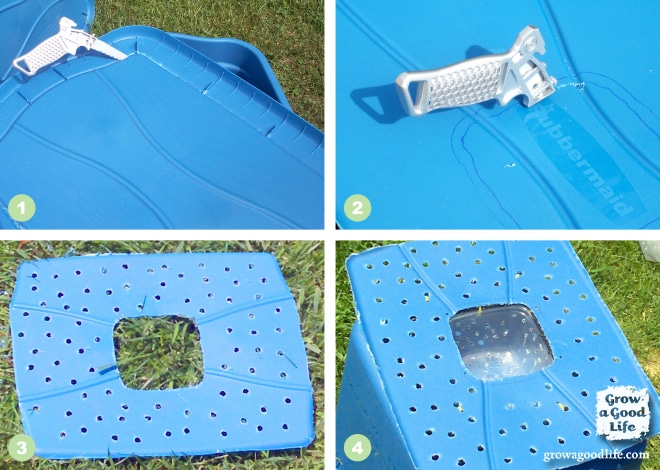
1. Remove the center of the lid. Carefully cut out the center of the lid to be used as the aeration shelf between the soil and the water chamber. Leave about two inches around the lid, so it can be used to hold the plastic mulch to the top of the container later.
2. Cut an opening for the wicking basket. Place your wicking basket at the center of the aeration shelf and trace the edges with your marking pen. Cut the opening slightly smaller (about 1/4-inch) than the outline.
3. Drill holes in the aeration shelf. Drill holes about 1-inch apart for air exchange.
4. Attach Wicking Basket to the aeration shelf. Drill holes a bunch of holes in the wicking basket to allow water to soak through. Drill holes around the edges and attach to the aeration shelf with zip ties.
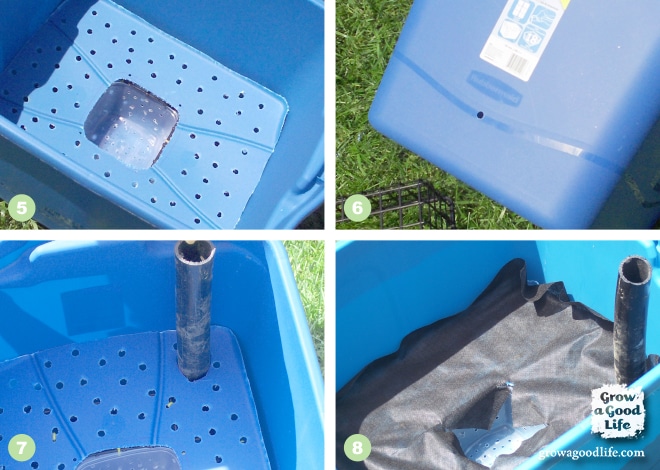
5. Check the fit. Assemble your shelf supports and aeration shelf inside the tote to check the fit. The shelf should fit snug against the tote with no buckling. Trim the shelf if needed.
6. Drill a 1⁄4-inch overfill hole about 1⁄2-inch below the aeration shelf. Water will come out the overfill hole when the container is full. The hole also allows air circulations between the aeration shelf and the water.
7. Cut an opening for the fill tube. Position fill tube, trace an outline, and cut out the hole for the tube.
8. Add landscape fabric. Trim a piece of landscape fabric to cover the aeration shelf. Try to leave a 2-inch overlap. Cut holes for the fill tube and the wicking chamber. The landscape fabric prevents the soil from dropping down into the water reservoir.
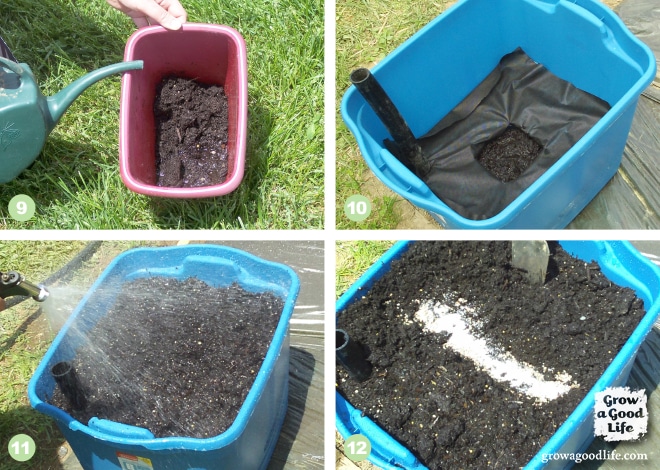
9. Add wet soil to wicking basket. Mix potting soil and water in a container until it is saturated. Pack into the wicking basket.
10. Move container to its final location. Place your self-watering container in its permanent location because it will be too heavy to move after adding the potting mix. Be sure the fill tube is easily reachable to fill with a hose.
11. Fill container with potting mix. Add the rest of the potting mix to the self watering container 3-inches at a time saturating each layer with water until the container is full. This is important, as dry potting mix will not wick water.
12. Add fertilizer. Dig a trench in the soil across the middle of the self watering planter and add 2-cups of fertilizer along the trench. Cover the fertilizer strip with potting mix and water in. Do not mix the fertilizer into the potting mix or spread it around.
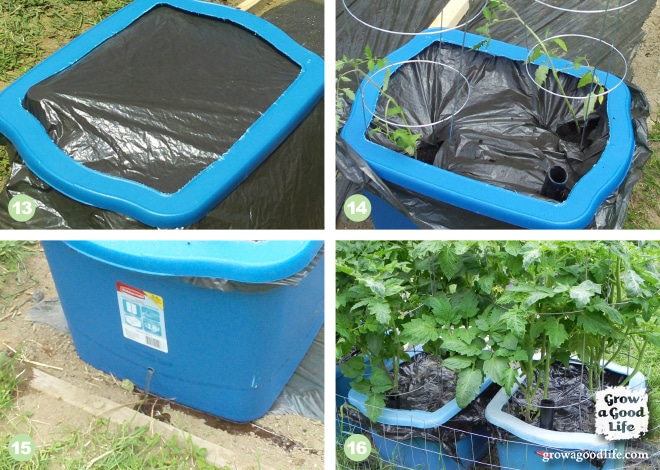
13. Layer plastic mulch. Lay the plastic garbage bag over the filled self watering container and snap on the cover. Cut a hole for the fill tube. The garbage bag will serve as a plastic mulch and help hold moisture in.
14. Plant. Avoiding the fertilizer strip, cut holes in the mulch and add your transplants. I plant two determinant or bush tomato plants in each 18-gallon self watering container, so I cut an X into the solar mulch where the tomatoes will be planted in opposite corners of the self-watering container.
15. Fill water reservoir compartment. Water through the fill tube until water comes out the overfill hole. Add plant supports if necessary. Keep water reservoir full or the wicking action will cease. Top off every day in the heat of summer.
16. Watch your plants grow and enjoy the harvest.
Additional Tips:
- Choose a Good Quality Tote: The Rubbermaid Roughneck and the Sterilite Ultra totes are more flexible and hold up to manipulation without cracking. I found these lovely blue ones on clearance for $5 and these are still being used years later. Simply drain water and store in a shed for winter. You should be able to find these totes at your local big box stores for under $10.
- Aeration Shelf Support: Be sure that whatever you use to hold up the aeration shelf is sturdy enough to support the weight of the potting mix when wet. I use recycled 30 oz. ground coffee containers cut in half to provide a stable shelf.
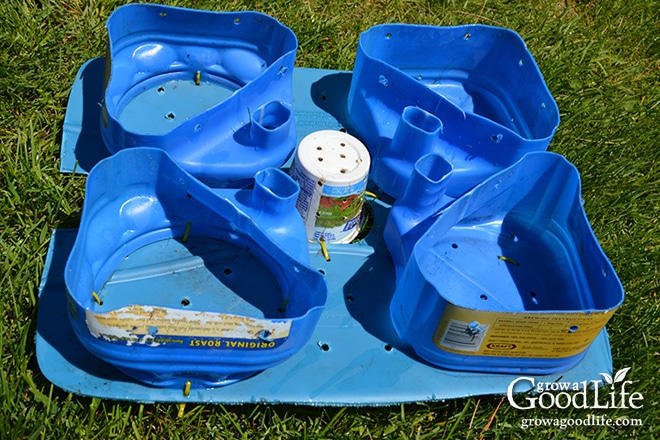
- Wicking Chamber: The wicking chamber container doesn’t need to be very large. I’ve used recycled food storage containers and 8 oz. yogurt containers.
- Potting Mix: Select a good quality, lightweight potting mix suitable for containers or mix your own at the ratio of 45% peat moss, 45% compost, 10% perlite, plus 2 cups of hydrated lime or dolomite. About 2 cubic feet is needed to fill one 18-gallon self watering container.
- Organic Fertilizer: I use Epsoma Plant-tone for growing vegetables and Tomato-Tone for tomatoes.
- Replanting: Reusing self watering planters is easy. Just remove the old plants and old fertilizer strip. Give the soil a deep soaking, replace fertilizer strip, fill reservoir chamber, and replant.
You May Also Like:
- 10 Steps to Starting Seedlings Indoors
- How to Grow Celery from Seed
- How to Harden Off Transplants
- Seasoned Tomato Sauce Recipe for Canning
Good planning is key to a successful vegetable garden
Whether you are new to growing your own food or have been growing a vegetable garden for years, you will benefit from some planning each year. You will find everything you need to organize and plan your vegetable garden in my PDF eBook, Grow a Good Life Guide to Planning Your Vegetable Garden.
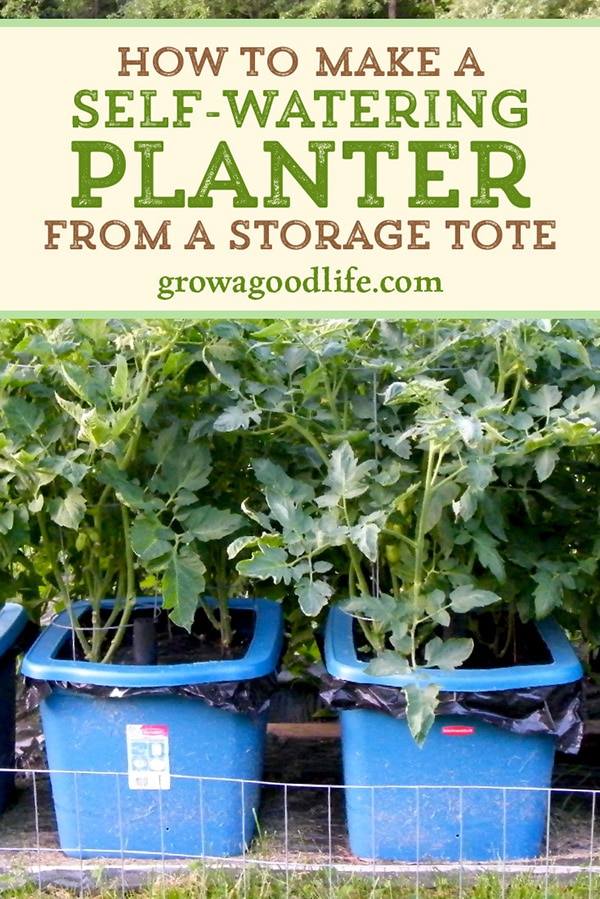


I was wondering if you can use one of those fabric plant containers for the wicking basket inside the self watering container
Thanks
Deneen, That’s a great question! A fabric plant container might work as a wicking basket, but I have not tried it myself, so I don’t know how it will perform. Let me know how it goes if you experiment with it!
What is your opinion on growing sweet corn in the self-watering container.
Also how often do you need to fill the pipe with water during a hot summer spell (85-90) Sacramento CA weather
Lowell, Growing sweet corn in a self-watering container can be a great idea, as it ensures the plants receive consistent moisture. However, sweet corn has deep roots and can grow quite tall, so make sure your container is large enough to support the plant’s growth. During a hot summer spell in Sacramento, you may need to fill the water reservoir daily or every other day to keep up with the corn’s water needs. Always check the water level and ensure the soil stays consistently moist.
Can you only plant one plant per container? Could you do 2?
Amber, Great question. The amount of plants depends on what you are growing and the size of your tote. I recommend the following for one 18-gallon self-watering container that is about 24 inches long x 16 inches wide and 16-inches deep:
2 Plants: Tomatoes, Eggplants, and Summer Squash
4 Plants: Celery, Peppers, Cucumbers.
6 Plants: Broccoli, Cabbage, Cauliflower, Swiss Chard
8 Plants: Lettuce, Spinach, and other Salad Greens
10 Plants: Beans, Beets, Carrots, Onions, Peas, Spinach, Turnip, Radishes
Some crops, such as tomatoes, cucumbers, peas, and pole beans, need a trellis to support the plants. Use the recommended spacing on the seed package as a guideline for spacing. Just remember to avoid the fertilizer strip. Please let me know if you need more information.
What is the measurement from the bottom of the tote to the bottom of the drain hole?
Phil, The location depends on what you are using to hold up the aeration shelf. Drill the overfill hole about 1/2-inch below the aeration shelf.
Could you use strips of cotton cloth to wick the water up from the reservoir to the soil?
C, I haven’t experimented with using cotton cloth, so I cannot advise.
I use a layer of stone to hold up my aeration plate. Which works great! This can make the container pretty heavy tho. So I set my container up on a cart with wheels. It makes it so I can move my plants very easily if I have to. For example, sunnier locations or inside a garage or green house if you live in an area that gets early frost. Happy Gardening!
Could I use six empty soda cans for support?
Laurie, I don’t think they will be strong enough to hold up the shelf, and they will corrode.
Could you use cloth in the wicking basket?
Petronella, You could use cloth to line the wicking basket before filling with soil.
does the dirt in the wicking basket come out the holes into the reservoir basket? if not, what prevents the dirt from spilling out?
Kris, Yes, some of the soil does get into the water chamber, but not enough to make a difference.
Do you find that when it rains, the water puddles on top of the plastic garbage bags?
Rose, The water doesn’t puddle on the covering because it isn’t completely sealed.